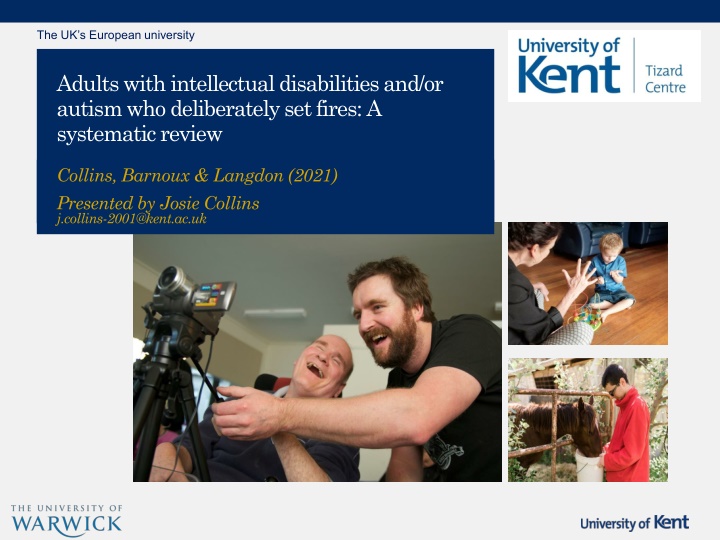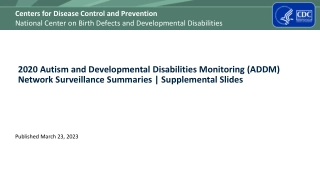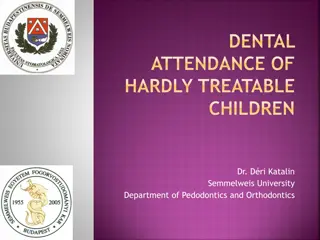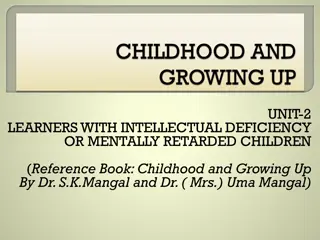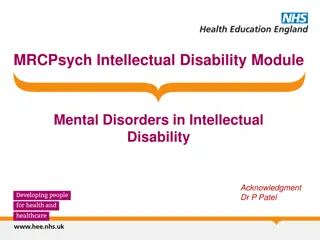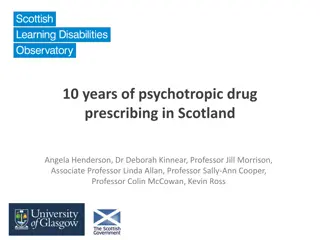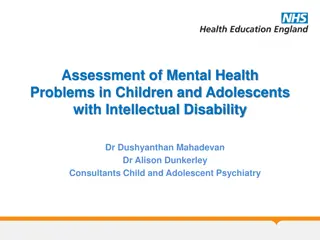Prevalence and Characteristics of Adults with Intellectual Disabilities and Autism Who Set Fires
This systematic review explores the prevalence, characteristics, and treatment needs of adults with intellectual disabilities and autism who engage in firesetting behavior. Research highlights the scale and cost implications, identifying essential assessment tools and interventions for clinicians. The study aims to shed light on offense-related characteristics and enhance understanding for effective interventions.
Download Presentation

Please find below an Image/Link to download the presentation.
The content on the website is provided AS IS for your information and personal use only. It may not be sold, licensed, or shared on other websites without obtaining consent from the author.If you encounter any issues during the download, it is possible that the publisher has removed the file from their server.
You are allowed to download the files provided on this website for personal or commercial use, subject to the condition that they are used lawfully. All files are the property of their respective owners.
The content on the website is provided AS IS for your information and personal use only. It may not be sold, licensed, or shared on other websites without obtaining consent from the author.
E N D
Presentation Transcript
The UKs European university Adults with intellectual disabilities and/or autism who deliberately set fires: A systematic review Collins, Barnoux & Langdon (2021) Presented by Josie Collins j.collins-2001@kent.ac.uk
Terminology Arson Pyromania Firesetting Intentional/reckless To destroy/damage property Clinical diagnosis Impulse control disorder All acts of intentionally setting a fire
Scale and Cost of Firesetting The Fire and Rescue Service attended to 83,221 incidents of deliberate firesetting in England (2018-19) 50 fire-related fatalities 1,014 non-fatal casualties requiring hospital treatment (Home Office, 2019). High economic burden 1.45 billion (Arson Prevention Forum, 2017). Relatively under-researched area until recently. Importance of understanding the characteristics and treatment needs of people who set fires due to scale and cost of the problem.
Prevalence of intellectual disabilities 1-22% (Alexander et al., 2011; Devapriam et al., 2007; Hall, et al., 2005; Murphy & Clare, 1996; Lees-Warley & Rose, 2015; Simpson & Hogg, 2001; Wheeler et al., 2009). The mATCH study suggests a prevalence rate of 6% (n=283) in adult male offenders with a diagnosis of Autism Spectrum Disorder (Langdon et al., unpublished). Supported by a recent review of autistic adults who have set fires (Allely, 2019).
Aims To identify the prevalence of autistic adults and adults with intellectual disabilities who set fires. To highlight the characteristics and treatment needs of autistic adults and adults with intellectual disabilities who set fires. To highlight offence related characteristics of autistic adults and adults with intellectual disabilities who set fires. To evaluate the assessment tools and interventions available to clinicians working with autistic adults and adults with intellectual disabilities who set fires.
Methodology Searches conducted on 1stMarch 2019 & 21stFebruary 2020. PsychINFO, PsychARTICLES, Medline, CINAHL Plus with Full Text, Criminal Justice Abstracts, SCOPUS, Open Grey), the University of Kent arson library and ancestry searches. No limits were applied to year of publication. Quality assessed using the MMAT (Hong et al., 2018).
Search Terms Autism terms autis* ASC Autism Spectrum Dis* ASD Autism Spectrum Condition* Intellectual disability terms learning dis* mental retardation intellectual dis* ID LD Firesetting terms arson fireset* fire?set* deliberate fire* fire rais* asperg* developmental dis* intellectually dis* intellectual and developmental fire start* criminal damage disorder IDD attention deficit* ADHD hyperkinetic PDD Pervasive developmental disorder
Inclusion Criteria Exclusion Criteria Empirical research. Written in English. Participants aged 18 and above. Autistic adults or adults with intellectual disabilities, and fire setting behaviour. Books, book chapters, magazines, abstract only, letter or reviews. Researchers were unable to differentiate a sub- sample of autistic adults and adults with intellectual disabilities who had set a fire from other cohorts in the method, analyses, or reporting of outcomes.
PRISMA flowchart 1525 records found through database searching (PsychINFO, PsychARTICLES, Medline, CINAHL Plus with Full Text, Criminal Justice Abstracts, SCOPUS) 715 records found through other sources (Open Grey, University of Kent arson library, ancestry searches) Identification 2240 results 1925 titles/abstracts excluded 230 x Below age 18 157 duplicates removed 10 x Language other than English 350 x No IDD Screening 745 x Non-empirical 2083 titles and abstracts reviewed 590 x No firesetting behaviour 51 full text articles excluded 1 x Below age 18 158 full text records to be reviewed 0 x Language other than English Eligibility 21 x No IDD 3 x Non-empirical 107 articles identified as relevant 13 x No firesetting behavior 13 x Unable to differentiate sub- sample 7 full text records not available for review Included 100 articles included
Findings Majority non-randomized comparison studies, recruiting from psychiatric services in the UK and collecting secondary data Poor methodological quality of research-29% of studies were rated 4-5* 31 studies were descriptive.
To identify the prevalence of autistic adults and adults with intellectual disabilities who set fires. The prevalence rate of autistic adults and adults with intellectual disabilities among people who set fires was 7.9% (n = 460) The prevalence rate of firesetting among autistic adults and adults with intellectual disabilities was 10.1% (n = 633) 94.7% of adults who set fires were reported to have intellectual disabilities, 5% of adults who set fires had autism 17.4% of the women (n = 86) and 11.2% of men (n = 182) who set fires were autistic and/or had intellectual disabilities
To highlight the characteristics and treatment needs of autistic adults and adults with intellectual disabilities who set fires. 17 to 77 years (n=260, 23 of 100 studies) Caucasian (n=111, 4 of 100 studies) Male IQ ranged from 42-98 (MIQ=66.7, SD=7.6, n=7) Difficulties with regulating emotions Poor skill development Low self esteem Comorbidity Developmental experiences included trauma and childhood abuse Difficulties forming healthy relationships, behavioural difficulties, skill deficits
To highlight offence related characteristics of autistic adults and adults with intellectual disabilities who set fires. Commonly motivated by revenge/anger. Varied offending history/no offending history Unique risk factors included: withdrawal/lack of support discussions about the future others doing something perceived as negative a perceived inability to effect social change feeling mistreated or not listened to feelings desperation and disempowerment a desire to enable positive emotional experiences (e.g. sensory stimulation) circumscribed interest in fire/violence Non-contact firesetting most common
To evaluate the assessment tools and interventions available to clinicians working with autistic adults and adults with intellectual disabilities who set fires. 4 studies used fire specific tools to assess participants (FAI, Murphy, 1990; FAS, Muckley, 1997; FIRS, Mouridsen et al., 2008; SAFARI, Long et al., 2014) 1 specialised intervention evaluated with a sample of autistic adults and adults with intellectual disabilities (n=14; Taylor et al., 2002; 2006) No evidence to suggest current interventions reduce the risk of reoffending Length of stay between 950.4-1725 days
In sum Small, ungeneralizable samples Poor study methodology A lack of appropriate measures used to collect data A lack of validated theory A lack of validated fire specific assessment tools A lack of validated interventions Limited understanding of the similarities and differences between adults with intellectual disabilities and/or autistic adults and other adults in contact with the Criminal Justice System.
Limitations Limitations of research o Limited sample sizes (ungeneralizable, unrepresentative) o Quality of research design and methodologies poor o Lack of comparison/control groups o Majority of studies did not assess IQ/ASD using a valid and reliable tool o Poor reporting (e.g. diagnosis, age, background) o Secondary data sources Limitations of review o Poor quality of research included o Publication bias
Implications & Conclusions A unique set of characteristics and risk factors is beginning to emerge within the literature The poor quality of evidence limits our current understanding of autistic adults and adults with intellectual disabilities The differences between autistic adults and adults who set fires with severe, moderate and mild intellectual disabilities are not considered within current research There is no theory to explain the offence process of autistic adults and adults with intellectual disabilities who set fires No empirically validated and reliable assessment tools to inform the assessment and formulation of risk or treatment plans of autistic adults and adults with intellectual disabilities who set fires No empirically validated treatment programme available to clinicians working with autistic adults or adults with intellectual disabilities who set fires.
For further information contact me: j.collins-2001@kent.ac.uk The Tizard Centre Provides undergraduate and postgraduate courses in intellectual disability (including forensic issues), autism studies, positive behaviour support and applied behaviour analysis. Engages in a wide variety of research primarily aimed at improving the quality of life of people with intellectual and developmental disabilities and people with mental health conditions Provides consultancy to a range of individuals, organisations in the UK and abroad For more information please see our website: https://www.kent.ac.uk/tizard/ or email: tizard-info@kent.ac.uk
